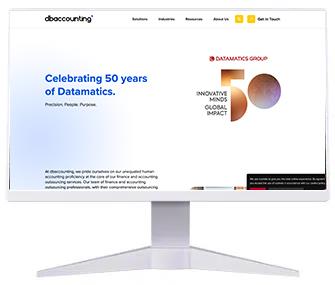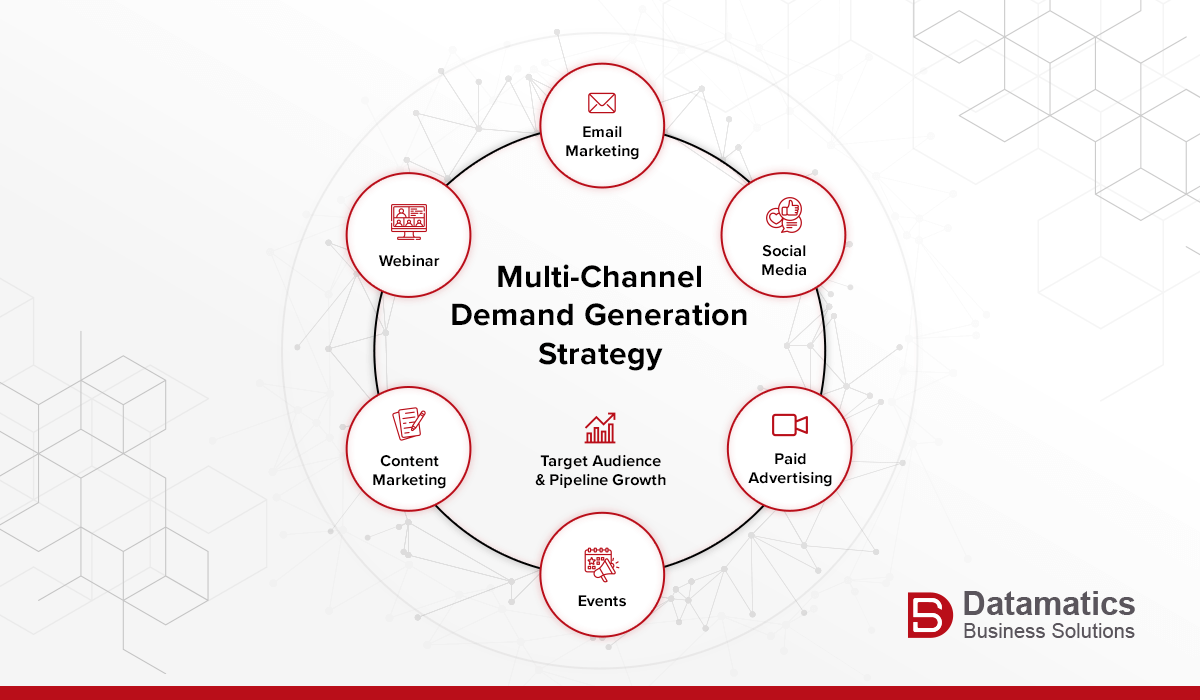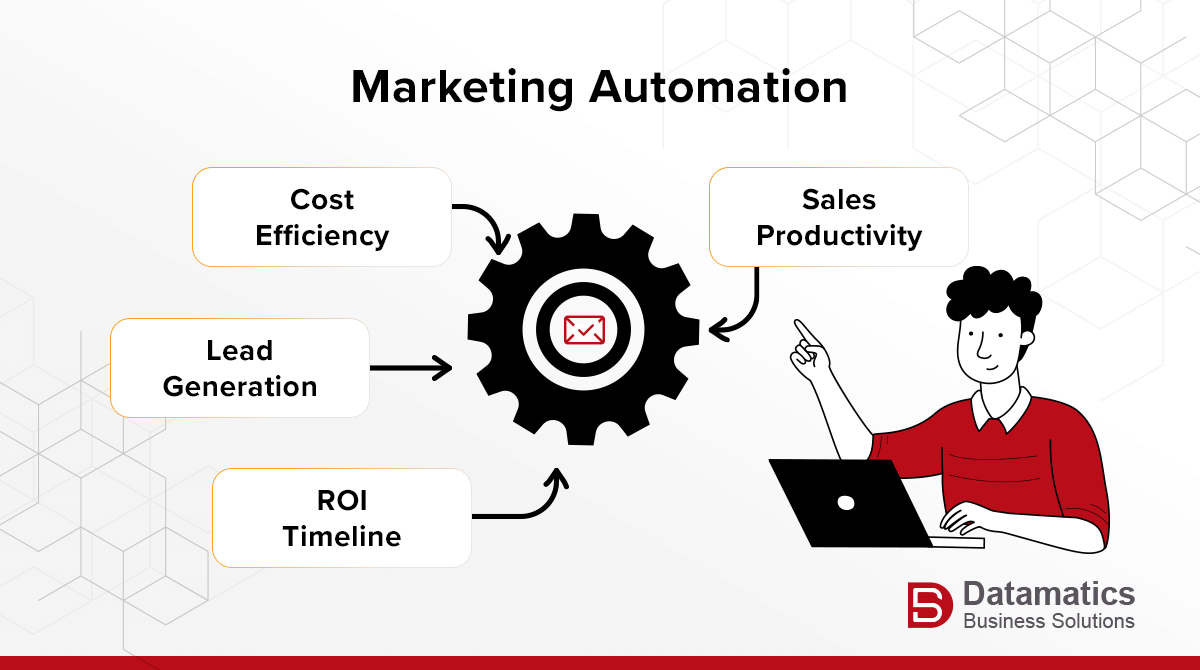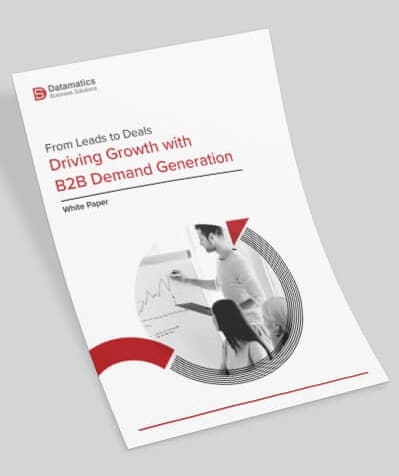Introduction
Running a paid campaign is only one piece of your B2B demand generation strategy. And relying solely on ads is a common mistake when it comes to your marketing efforts.
In today’s complex market landscape, with multiple buying groups and growing competition, a successful demand generation approach needs more than just significant marketing spend.
For a successful demand generation strategy, you need a strategic, multi-faceted plan that addresses various touchpoints, builds relationships, and aligns with the evolving behaviors of your target audience.
Demand generation is both an art and a science. It involves the strategic orchestration of various tactics to attract, engage, and convert potential customers.
Approaching demand generation with a meticulously crafted strategy is crucial. While the ultimate objective is to build a robust pipeline of Marketing Qualified Leads (MQLs), these must be nurtured into loyal customers. It is equally important to focus on building awareness, establishing trust, and providing valuable insights.
Let us explore six such essential elements that make a successful demand generation strategy.
How do You Differentiate Between an Effective and Ineffective Demand Generation Strategy?
Let’s get one thing clear – demand generation is not about chasing massive quantity of leads. It is about generating quality leads. You know here quality presides quantity.
An effective demand generation strategy seamlessly integrates multiple elements to attract, engage, and convert prospects into qualified leads, ultimately fueling consistent revenue growth.
At its core, such a strategy is data-driven, customer-centric, and aligned closely with sales teams, ensuring marketing efforts translate into tangible business outcomes. According to Demand Gen Report, 45% of marketers consider demand generation a strategic growth tactic. They have highlighted that the recognition of its importance when executed properly.
In contrast, ineffective demand generation often results from fragmented campaigns, poor target audience understanding, and lack of measurable results. For instance, Marketing Sherpa estimates that about 32% of B2B marketing budgets are wasted due to inefficient demand generation tactics, underscoring the high cost of suboptimal approaches.
Effective strategies prioritize building strong buyer personas and employ multi-channel marketing tactics across email, social media, content marketing, and paid campaigns. HubSpot reports that companies using multi-channel strategies achieve a 9.5% average annual revenue increase, compared to single-channel approaches.
Equally important is the continuous measurement and optimization of campaigns. However, only 49% of marketers actively track campaign performance for demand generation, which can be a key differentiator in effectiveness.
Furthermore, ineffective demand gen often fails to address the complexity of modern buying groups. Research reveals companies with misaligned demand generation strategies experience sales cycles that are 47% longer than those with optimized strategies.
Therefore, an effective demand generation strategy is integrated, measurable, and adaptive, while an ineffective one is siloed, poorly targeted, and lacks accountability.
Key Takeaway
Demand generation isn’t about chasing leads. It is about generating the right leads. Integrated, data-driven, and sales-aligned strategies maximize engagement, shorten sales cycles, and drive measurable revenue growth. That is what an effective demand generation strategy is.
What is Demand Generation?
Demand generation is the art (and also science) of sparking interest, nurturing engagement, and guiding the right prospects through a seamless buying journey. It blends data-driven insights, multi-channel campaigns, and close sales alignment to transform awareness into high-quality opportunities. It is a great way to fuel predictable and scalable revenue growth.
What is the difference between Demand Generation and Lead Generation?
Demand Generation is the overarching marketing strategy focused on creating excitement, awareness, and long-term interest in your company’s products or services. It targets the entire market, even those not actively looking to buy, with the goal of positioning your brand as a trusted authority.
Lead Generation is a specific tactical step within the demand generation process. Its goal is to capture the contact information (a “lead”) of a prospect who has already shown interest.
Demand generation gets people interested. Lead generation collects their data.
What are the key metrics (KPIs) for measuring demand generation success?
Successful demand generation is measured by metrics that show you are effectively building interest and moving prospects through the funnel. Key KPIs include:
- Marketing Qualified Leads (MQLs): Prospects deemed ready to be handed off to the sales team.
- Sales Qualified Leads (SQLs): MQLs that have been accepted and qualified by the sales team.
- Cost Per Acquisition (CPA): The total cost to acquire a paying customer.
- Customer Lifetime Value (CLV): The total revenue a customer is expected to generate over their relationship with your company.
- Funnel Conversion Rates: The percentage of prospects who successfully move from one stage of the sales funnel to the next (e.g., from MQL to SQL).
How do Sales and Marketing teams align in a successful demand generation strategy?
Alignment between Sales and Marketing, often called “Smarketing,” is critical for demand generation success. They must agree on shared goals and definitions. This includes:
Shared Definitions: Both teams must agree on what constitutes a quality lead (e.g., the criteria for an MQL and SQL).
Lead Handoff Process: Marketing must consistently deliver qualified leads to sales, and sales must provide feedback on the quality of those leads.
Content Strategy: Sales provides insights into customer pain points and questions, which marketing then uses to create the high-value content necessary for the demand generation process.
Shared KPIs: Aligning metrics like pipeline contribution and revenue ensures both teams are working toward the same business outcomes.
How Does Knowing Your Target Audience Strengthen Your Demand Generation Strategy?
The first step of a successful demand generation strategy – knowing your audience. Understanding your target audience is the foundation of every successful demand generation strategy. When you define your ideal customer profile (ICP) and align your approach, you gain a lot:
Stronger Messaging & Targeting
Understanding your target audience starts with defining your Ideal Customer Profile (ICP), which allows you to craft tailored content and campaigns that resonate deeply with prospects.
When marketing messages speak directly to the specific needs, challenges, and aspirations of your ICP, engagement naturally improves.
This personalization builds trust and relevance, leading to conversion rates that can be up to three times higher compared to generic, broad messaging.
Market Research-Driven Insights
Backing your ICP with rigorous market research such as surveys, focus groups, and competitor analysis uncovers critical insights into your audience’s preferences and pain points.
This deep understanding helps you anticipate buyer behavior more accurately and align your messaging to meet expectations.
Nearly 80% of businesses leverage this research to refine customer and competitive strategies, which leads to more efficient resource allocation and stronger campaign outcomes.
Leverage Social Media for Audience Intelligence
Social media platforms offer a treasure trove of real-time data about demographics, interests, and engagement trends.
Marketers increasingly tap into this information to sharpen their audience targeting. With 76% of marketers using social media analytics, it is clear that these platforms provide valuable signals that enable campaigns to be more timely, personalized, and impactful.
Data & Analytics for Precision Targeting
High-quality customer data sourced from CRM systems and behavioral tracking reveals patterns, preferences, and emerging trends among your existing customer base.
Marketers who prioritize data-driven segmentation and targeting benefit from campaigns that spend budget more efficiently, focusing efforts on the most promising leads.
This precision plays a pivotal role in driving demand generation success, as recognized by 82% of marketers
Improved ROI & Campaign Efficiency
When your ICP is defined and combined with data-driven targeting, marketing campaigns not only reach the right audience but also deliver measurable results. Advanced audience segmentation can lead to remarkable revenue increases, such as a 760% boost in email campaign-generated revenue.
This efficient use of budget reduces wastage and ensures that every marketing dollar spent accelerates demand and pipeline growth.
Key Takeaway
Understanding your target audience is crucial for a successful demand generation strategy. Defining your ideal customer profile (ICP) enables you to tailor your messaging and campaigns so they resonate deeply with prospects, leading to higher engagement and conversions.
Demand Generation Strategy & The Art of Creating a Compelling Value Proposition
A compelling value proposition is a critical driver of success for any B2B demand generation strategy. It serves as the cornerstone for attracting attention, improving conversion rates, and building lasting trust with your target audience.
When clearly articulated, your value proposition communicates the unique benefits your product or service delivers, helping potential customers understand why they should choose you over competitors.
For example, landing pages featuring a well-defined value proposition can achieve significantly higher conversion rates, emphasizing its direct impact on demand generation performance.
Moreover, a strong value proposition enhances lead quality, drawing in prospects who are genuinely interested and more likely to convert. It acts as a filter that helps identify and nurture the best-fit leads, ensuring that marketing efforts focus on meaningful engagements rather than broad, unfocused outreach.
Equally important is the role it plays in driving brand trust and credibility. Consumers increasingly form relationships with brands that demonstrate shared values, making your value proposition a foundation for emotional and rational connection alike.
From a revenue perspective, companies with well-crafted, customer-centric value propositions achieve notably higher growth rates compared to their peers. This advantage comes from delivering clear, relevant messages that address real customer pain points and priorities.
To maximize the effectiveness of your demand generation campaigns, it is essential to consistently refine and align your value proposition with evolving market conditions and customer feedback.
Key Takeaway
A compelling value proposition not only differentiates your brand but also powers better lead engagement, higher conversion rates, and accelerated revenue growth, making it an indispensable element of a winning demand generation strategy.
A Winning Demand Generation Strategy Always Goes Multi-Channel
A multi-channel demand generation strategy is essential for effectively reaching and engaging your target audience across diverse platforms. Instead of relying on a single marketing channel, businesses use a combination of email, social media, paid search, content marketing, podcasts, and events to deliver the right message at the right time, ensuring consistent brand visibility throughout the customer journey.
A MarTech company targeting business leaders may start by creating awareness with LinkedIn ads promoting valuable guides. Once prospects engage, they are nurtured with educational content such as blog posts, webinars, and retargeting ads that demonstrate ROI. This multi-touch approach builds trust and familiarity over time, maximizing the likelihood of conversion.
The benefits of this strategy are significant. Meeting your audience where they spend their time allows you to connect with a wider range of prospects. So be it the younger demographics on TikTok or the traditional one on LinkedIn.
Repeated exposure across channels accelerates the buying cycle, leading to faster conversions.
But even if you are targeting your prospect using multiple channels, success is not a guarantee. Not unless you have your strategy and goals set.
Setting SMART goals is crucial for multi-channel success. This ensures that each campaign is specific, measurable, achievable, relevant, and time-bound. Real-time tracking and optimization help companies allocate budget efficiently and refine plans dynamically.
By embracing a multi-channel strategy, businesses not only increase their reach but also enhance customer engagement and retention, paving the way for sustained revenue growth and competitive advantage.
Key Takeaway
Multi-channel marketing increases reach, boosts credibility, and diversifies customer engagement, reducing risk and driving retention.
You can also read: 5 Signs Your Business Needs Demand Generation Services Now
Creating Engaging Content for Your Demand Generation Campaign
Content fuels demand generation by educating prospects, nurturing trust, and driving conversions. So, if you really want to succeed in your demand generation campaigns, you need to ensure that your content is top-notch. But how to ensure that? Here are a few things you can keep in mind.
Content Marketing Effectiveness
According to the Content Marketing Institute, 83% of marketers consider content marketing their most effective demand generation tactic.
This highlights how valuable educational and informative content is in attracting and engaging potential customers. Well-crafted content answers questions, solves problems, and positions brands as trusted advisors, guiding buyers along their journey.
Rising Investment
In 2024, almost 50% of marketers boosted their content budgets to enhance brand awareness and deepen audience engagement. This investment reflects the strategic importance of content as a long-term asset.
Let’s be real that content cultivates relationships and fuels lead generation consistently. Organizations recognize that quality content generates ongoing ROI beyond immediate campaigns.
B2B Engagement with Webinars
Webinars are especially powerful in the B2B space, with 45% of marketers citing them as the most effective top-of-funnel tactic.
These interactive events allow direct dialogue, real-time problem solving, and personalized engagement, fostering a connection that static content alone can’t achieve. Webinars help establish authority and accelerate lead qualification.
Authority Building
Brands publishing authoritative content enjoy markedly better returns, being 13 times more likely to see positive ROI, according to HubSpot data.
Authoritative content builds credibility by demonstrating expertise and delivering value, which helps businesses differentiate themselves in crowded markets and nurture long-term trust with buyers.
Key Takeaway
High-value, problem-solving content positions your brand as an authority, fueling awareness, lead generation, and customer trust.
Harnessing the Power of Marketing Automation in Your Demand Generation Strategy
Marketing teams today are expected to do more with less. They have to generate high-quality leads, nurture them effectively, and drive revenue, all the while managing multiple channels and shrinking timelines. That is exactly where marketing automation comes to play.
Automation has become a critical pillar of modern demand generation strategies, helping businesses scale their efforts, personalize engagement, and turn prospects into loyal customers.
Demand generation is fundamentally about raising awareness, igniting interest, and assisting prospective customers in making decisions. But you can only go so far with manual processes. This entire cycle is streamlined via marketing automation.
Most marketers can make smarter decisions by automating repetitive operations like lead acquisition and email follow-ups.
Businesses who employ marketing automation experience an improvement in their sales pipeline contribution of at least 10%, according to Forrester. However, this shouldn’t be shocking. Marketing automation ensures that every touchpoint is timely and pertinent. It ensures that no lead is missed, and the marketing and sales teams collaborate thanks to automation.
One of the biggest advantages of marketing automation is its impact on lead generation and nurturing. By using tools that segment audiences, track behavior, and deliver personalized messaging, businesses can reach the right people at the right time.
A study by Oracle found that 80% of companies using marketing automation generate more leads, and 77% see higher conversion rates. Automation platforms make it easy to launch multi-channel campaigns as well. This includes emails, social media, webinars, or content syndication. And all of this can be done without manually managing every step. This means your team spends less time on execution and more time refining strategy and creative.
In addition to the aforementioned benefits, lead nurturing also becomes far more effective. Depending on a prospect’s position in the funnel, automated workflows can present tailored material. This guarantees regular and significant interaction. This raises conversion rates over time and fosters brand attachment and trust.
However, the benefits of marketing automation are not limited to marketing. It trackles down to the sales teams too. By automatically scoring leads and prioritizing high-intent prospects, sales reps can focus on opportunities that are most likely to close. Salesforce reports a 14.5% increase in sales productivity for teams that use automation.
On the marketing side, automation facilitates real-time campaign performance tracking, enabling teams to swiftly refine plans and wisely manage expenditures. Within a year, 76% of businesses that use marketing automation report a favorable return on investment.
Marketing automation used to be considered a “nice-to-have.” It now serves as the catalyst for sustainable, scalable demand creation. It helps teams work together more effectively, improves targeting, and allows companies to expand without having to hire more employees. More significantly, it turns unstructured data into insightful knowledge that helps marketers stay ahead of the competition and make better decisions.
In a world where customers demand individualized experiences and prompt responses, marketing is an essential element. Your demand generation plan may flourish with the speed, accuracy, and scalability that marketing automation provides.
Key Takeaway
Marketing automation helps teams cut the clutter, reach the right people at the right time, and turn raw data into real results. From smarter targeting to faster conversions and stronger sales alignment, automation gives marketing the speed, precision, and scale it needs to thrive in a competitive landscape.
Explore More: Demand Generation Process: Demystifying 6 Common Myths for B2B Marketers
Tracking and Analyzing Campaign Performances
Performance tracking is the cornerstone of effective demand generation. Even with the right ICPs, multi-channel approach, and automation tools, the effectiveness of demand generation can be judged only when it is tracked.
Optimization is a big part of any campaign. By leveraging real-time analytics, businesses can adjust strategies on the fly and ensure marketing efforts translate directly into revenue growth.
Tracking and analyzing performance empowers marketers to maximize ROI, understand audience behavior, and continuously refine campaigns for better results.
Campaign Effectiveness
A Hubspot report said that 63% of marketers measure conversion rates as their top KPI for demand generation. Monitoring conversions at every stage of the funnel—from awareness to decision – allows teams to identify bottlenecks, optimize touchpoints, and ensure campaigns are achieving desired outcomes. This focus on actionable metrics helps prioritize high-performing channels and strategies, maximizing overall campaign impact.
Resource Optimization
Data-backed campaign adjustments improve ROI by 20–30% said a study by McKinsey. By analyzing campaign performance, you can reallocate budgets, refine messaging, and optimize targeting.
By doing this, you can ensure that every dollar spent, and every hour invested delivers maximum value. Also, it helps reduce wasted efforts. And you know what, this will also help you derive the result you are looking for.
Revenue Impact
If you are spending a significant amount of money on campaigns, you want some return from it. And we have seen that companies using advanced analytics are 2.6x more likely to outperform peers in revenue growth.
Performance tracking goes beyond marketing metrics. It ties campaigns directly to revenue outcomes. By connecting marketing efforts to pipeline results, businesses gain insight into which strategies truly drive growth, enabling more strategic decision-making and predictable revenue expansion.
Audience Insights
There is one more advantage to performance tracking. It helps uncover new audience segments. And you what happens when that happens? 28% higher engagement rates.
By analyzing behavioral patterns, engagement data, and content interactions, marketers can identify previously untapped segments, create personalized campaigns, and deliver messaging that resonates. This intelligence ensures that campaigns are not only reaching audiences but also engaging them meaningfully for better conversion rates.
Key Takeaway
Tracking and analytics turn raw campaign data into insights, enabling smarter targeting, better messaging, and consistent performance improvement.
How does Datamatics Help with Demand Generation?
Datamatics supercharges the pipeline by transforming mere interest into actionable, sales-ready leads through a sophisticated, data-first approach.
We move beyond generic outreach by leveraging advanced intent-based demand generation, identifying prospects who are actively researching solutions like yours. Our strategy then orchestrates a multi-channel symphony. We distribute high-value thought leadership via content syndication and engage prospects with targeted email campaigns.
To ensure quality, we employ a precise single-touch or double-touch qualification model, often utilizing tele-verification to generate rigorous BANT (Budget, Authority, Need, Timeframe) leads. This seamless process guarantees your sales team receives high-quality, pre-qualified prospects who are demonstrably ready to convert, accelerating your revenue growth.
With 50+ years of experience in the industry, we ensure that you meet your targets. If you are interested in exploring our services, fill out your details here, and our representatives will get in touch with you.
Conclusion
To sum things up, any successful demand generation strategy must comprise of these six essential elements. These elements will help you attract, engage, and convert your prospects into qualified leads and consequently revenue growth for your business.
If you are looking to set up your demand generation campaigns that are actually successful, we can help you.
If you like what you read, subscribe to our newsletter and stay on top of the latest trends.

Paul van de Kamp





